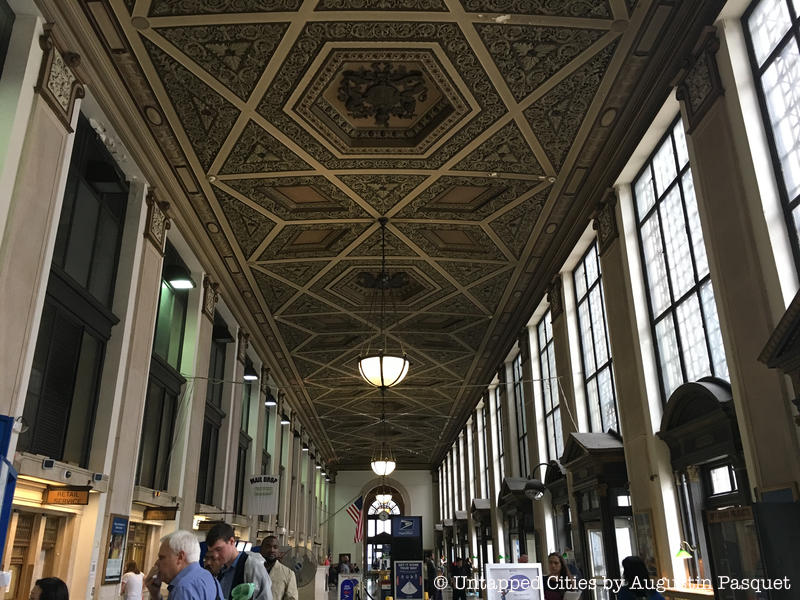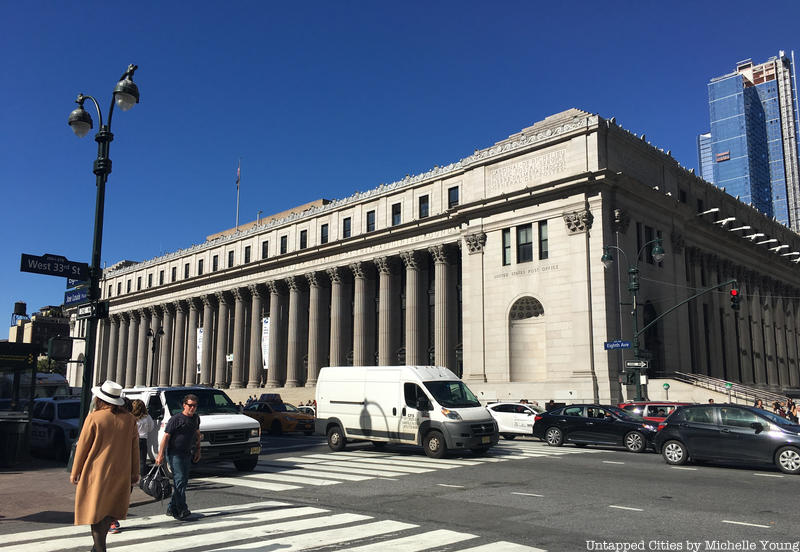
The main United States Postal Service building in New York City, the James A. Farley Post Office (formerly known as the General Post Office) is widely recognized for its beauty and imposing footprint. Designed by McKim, Mead, and White to complement the original Pennsylvania Station, the structure, built in 1912 and designated a landmark in 1966, occupies two full city blocks. Aside from its size, however, its lauded for being an “outstanding example of the Roman Classic Style” that features fifty three Corinthian columns topped by a frieze.
Although 16,000 workers used to be employed at the post office, it now supports less than 200 workers. Even so, it’s certainly no less grand. Now, with plans underway to convert the Farley Post Office into Moynihan Station — which will include a train hall for both the Long Island Railroad and Amtrak — this stately post office behind Penn Station is on target to get more attention that it has in the last fifty years. Here are some of its many secrets:
10. There’s a Postal Museum Inside the James A. Farley Post Office
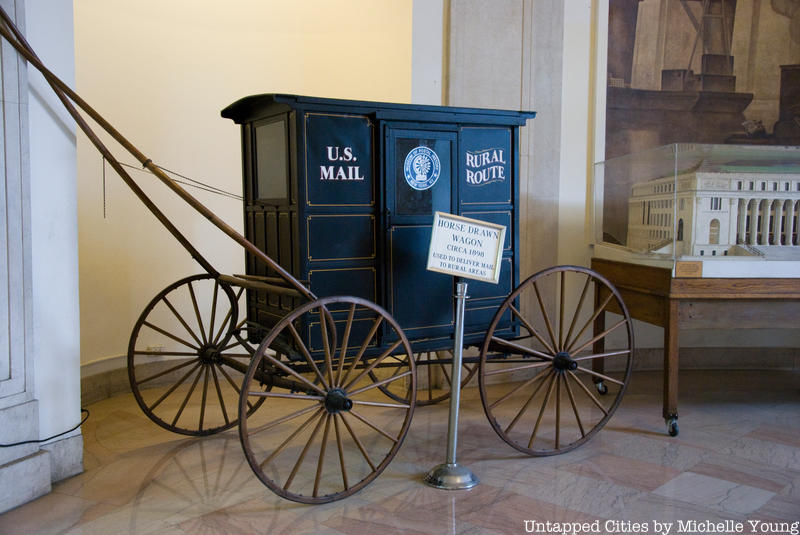
In one of the many things that have been forgotten in the James A. Farley Post Office is the Museum of Postal History, which contains a fun vintage collection of mail paraphernalia from the United States and other countries. Tucked behind the passport section, 99% of people miss this little museum — and not surprisingly, since the easiest way to discover it is through trespassing other areas. It’s also hard to find too much information online about it.
The objects on display range from horse drawn wagons to post boxes to wooden postcards. The main area of the museum also contains original service counters. Read more about the space here, and discover its many treasures.
9. The Seals in the Ceiling of James A. Farley Post Office
One of the lesser-known and more surprising details of the Farley Post Office is on the ceiling of its main atrium. If you take a moment to look up, you may be surprised to find that it is adorned with the official seals of ten countries including France, Germany and England, in addition to the United States.
The insignias represent ten countries that were one of the first members of the universal postal union at the time of the construction. This administrative body is now under the purview of the United Nations and works on shipping policies between countries around the world.
The United States seal is centered in the atrium, surrounded by those of England and Germany. The English seal contains the French phrase, “Dieu et Mon Doit” meaning “God and my right.” The German seal became a topic of controversy when the United States entered World War I four years after the opening of the Farley Post Office, with groups requesting a removal. The German seal shows the coat of arms under Francis II, of Francis I of Austria, from the early 1800s. Other countries include the R.F. for France (which stands for République Française), Switzerland, Belgium (with the French words “L’Union Fait la Force” (meaning Strength with Unity), the Netherlands (Je Maintiendrai, meaning “I will maintain.” Read more about the seals here.
8. The Secret Farley-Morgan Postal Tunnel Inside the James A. Farley Post Office
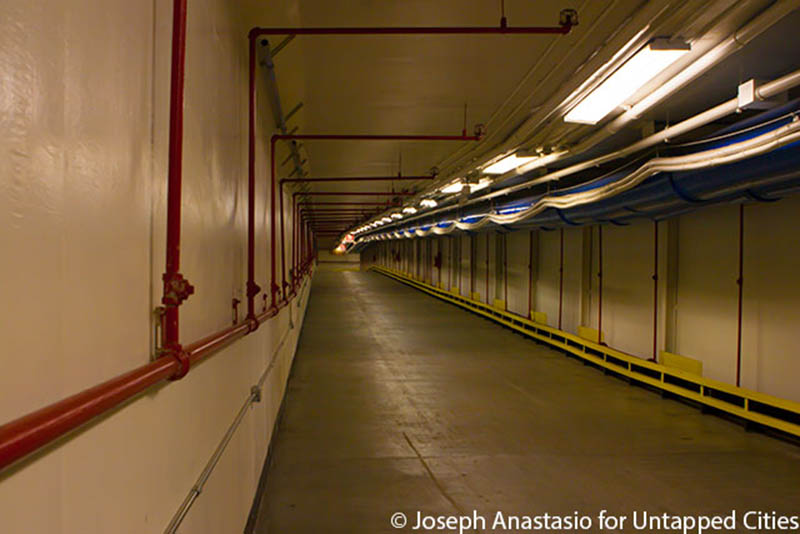 The Farley-Morgan tunnel under 9th avenue
The Farley-Morgan tunnel under 9th avenue
One of the least known tunnels in New York City is the postal tunnel that runs under the east side of 9th avenue between the Morgan (mail) sorting facility and the basement of the James A. Farley post office. This heavily secured road tunnel was used to move mail to and from a special ‘secret’ platform at Penn Station, where letters and packages would be transported on Amtrak trains. Amtrak even had a special ‘mail only’ train for a few years, running along the northeast corridor.
They stopped hauling mail in the early 2000s, and the stairs and elevators to the platform were sealed shut. Also, check out other secret New York City tunnels.
7. Remnants of a WPA Mural Can Be Found Inside the James A. Farley Post Office Annex

Aside from housing a museum, the James A. Farley Post Office is also sort of an art gallery in and of itself. Enter the lobby and you’ll catch sight of two large oil paintings by Russian artist, Louis Lozowick, which feature the Triborough Bridge and Lower Manhattan (although the lower portion of Lower Manhattan has been covered by a memorial plaque).
Hidden away inside the lobby of the James A. Farley Post Office annex building, however, are the remnants of a WPA mural by California artist Channing Peake, which is unfortunately inaccessible to the public (see photos of it here). (This may change however, as the plans to convert the Farley Post Office into a train station and Amtrak waiting room). The piece itself dates back to 1936, and was originally planned as three separate panels (a Dust Bowl scene, a river flood scene and a harvest scene). However only the scene that depicts a great river flood in Johnstown Pennsylvania was actually completed. It’s in pretty bad shape, but it stands as an interesting piece of history. The New York Landmarks Preservation Commission even refers to it as “New York’s Pompeii.”
6. There‘s an Event Space for Fashion Shows Inside the James A. Farley Post Office
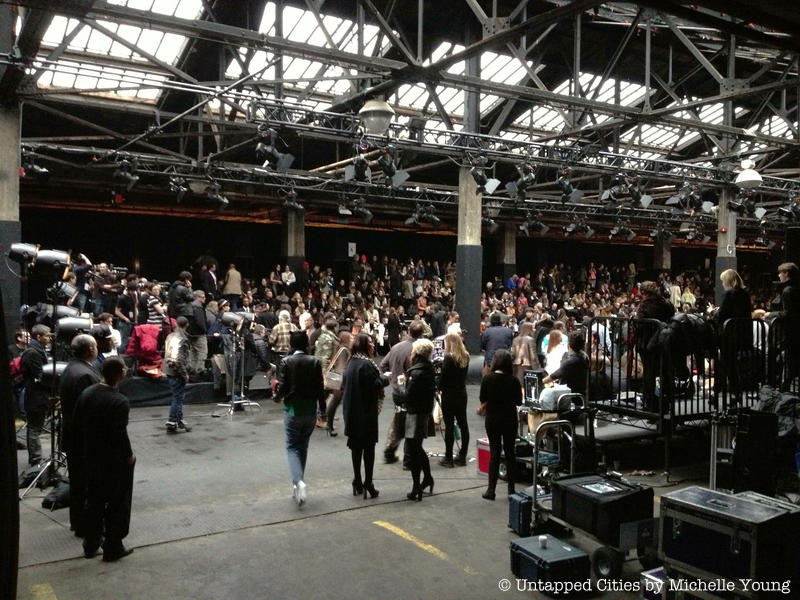
Did you know that the James A. Farley Post Office houses an event space for fashion shows? In 2013, Untapped Cities founder, Michelle Young, had the opportunity to step inside for the 3.1 Phillip Lim Fashion Week Show. Called Skylight at Moynihan Station, the venue occupies the industrial space of the building, also known as the mail sorting room and postal dock.
According to Skylight Studio’s website, the mail sorting room features a 47-feet-high, dome ceiling, “lustrous” black tile floor and 45,000-square-feet of interior space. The Postal Dock, on the other hand, has an industrial steel and glass skylight ceiling, 26,000-square-feet of interior space and a ceiling height of 30 feet.
5. The Abandoned Spaces Inside the James A. Farley Post Office
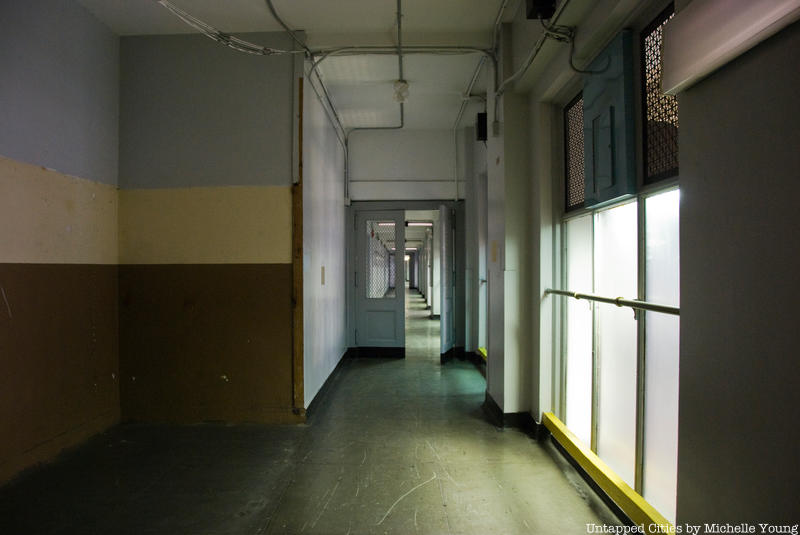
As urban explorers know well, even when you’re shown off-limits places, you know there are even more. The post office supported 16,000 workers at its peak, but less than 200 today. You can imagine just how many abandoned spaces there are inside, a concept explored by the artist Katarzyna Krakowaik in a past art installation by Storefront for Art and Architecture.
The project took place in a former police corridor just above the service counters in the main hall. “The lookout gallery,” a name dubbed by the workers, is actually an extensive system of secret corridors that connected thousands of rooms in the old Post Office, with small eyeholes for postal policemen to control the working environment through an analog CCTV.
We also did our own exploring (see photos) until a postal worker kindly took us seemingly lost souls back to the main hall, exiting at the quirky Museum of Postal History. It looks like some other readers took the cue and got even deeper into the post office than we did, infiltrating the very areas that inspired Krakowaik — the spaces for workers that were under observation by the police lookout gallery. Instagram user rysgam submitted several photographs to the Untapped Cities photo pool, which you can find here.
4. The James A. Farley Post Office Is Home to Operation Santa
As New York City’s main postal office, the James A. Farley Post Office is expectedly responsible for handling a wide range of duties. This includes Operation Santa, a program that launched in 1912 that authorizes postmasters to answer letters sent to Santa Claus.
December 10th is the deadline to send in your greetings to Santa, and there are two separate addresses to reach him at:
- For a Santa Claus holiday postmark: Santa Claus, PO Box 202, Santa Claus, IN 47579
- For a North Pole holiday postmark: North Pole Holiday Postmark, Postmaster, 4141 Postmark Dr, Anchorage, AK 99530-9998
3. Why Is Cardinal De Richelieu’s Name on the James A. Farley Post Office?
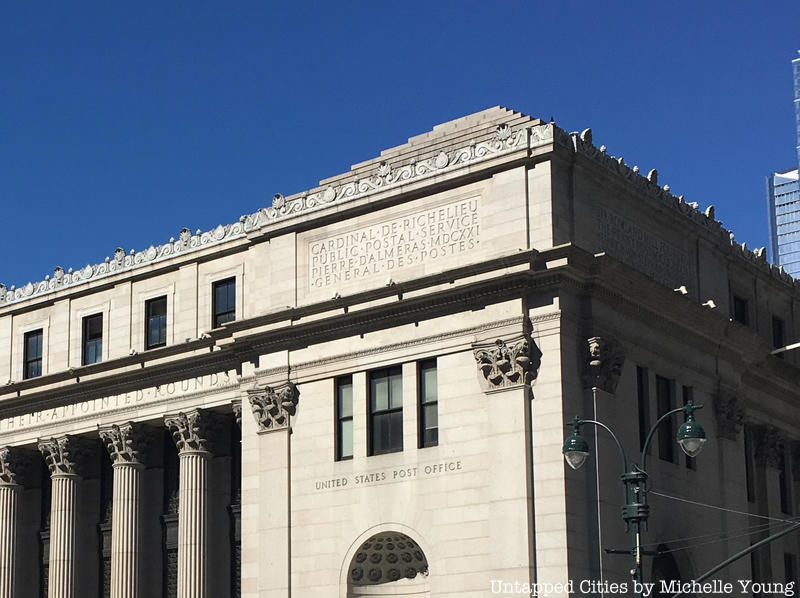 Inscriptions on the James A. Farley Post Office near Penn Station
Inscriptions on the James A. Farley Post Office near Penn Station
Look up at the facade of the James A. Farley Post Office and you’ll notice an inscription of Cardinal de Richelieu’s name (along with a few other French names) in the top right corner. Why is a 17th century French clergyman’s name inscribed on a U.S. Postal Service building?
It turns out that the architect of the building, William Mitchell Kendall, paid tribute to the 2000+ year history of mail delivery by inscribing the names of key postal players on the corners of the building. Under each name is a description of the person’s contribution. Cardinal de Richelieu was included because he made the French postal service more accessible to the public (his description reads “Public Postal Service”).Other names on the Eighth Avenue facade include King Louis XI, who instigated Europe’s first postal service (“Created the Post Royale”), and Franz von Taxis (of Thurn and Taxis), who helped organize permanent postal service between European nations (“Imperial Postmaster”).
Names on the 31st Street facade range from Persian Emperor Cyrus, who sent mounted relay messengers throughout sixth century B.C. Egypt, to Charlemagne, who spread the preexisting Roman postal network to Italy, Germany, and France. Lastly, the 33rd Street names include Andrew Hamilton, Colonial Governor of New Jersey who patented the colonies’ first postal service, and Sir Rowland Hill, a 19th century Englishman who pushed for reforms in the British postal service.
Also, have you noticed the building’s more prominent inscription across the 8th Avenue facade? It reads, “Neither snow nor rain nor heat nor gloom of night stays these couriers from the swift completion of their appointed rounds.” Commonly thought to be the creed of the U.S. Postal Service, this inscription actually has no official purpose. Kendall pulled the text from Herodotus’s Histories, which described the messenger system of instituted by Cyrus in Persia.
2. The James A. Farley Post Office Was Once New York City’s Only 24-Hour Post Office
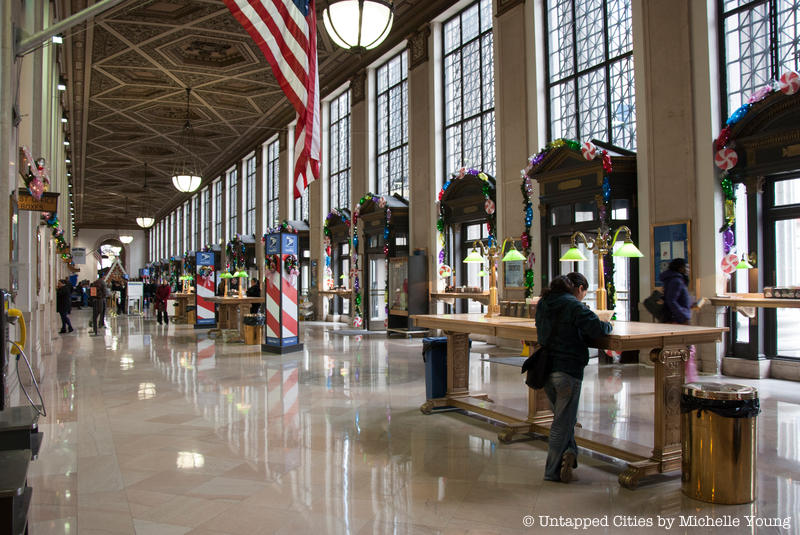
The James A. Farley Post office once held the distinction of being New York City’s only 24-hour post office that was open seven days a week. In 2009, however, the retail hours were changed due to a “significant drop in customer usage.” In fact, Silive.com reported that mail volume declined by 9.5 billion pieces in 2008, prompting the Postal Service to send out a warning that it would run out of money without congressional action.
While the James A. Farley Post Office is no longer a 24-hour facility, it does still keep its lobby open all night, providing access to post office boxes and automated kiosks for buying stamps and mailing packages.
1. The James A. Farley Post Office Provides New Access to the LIRR
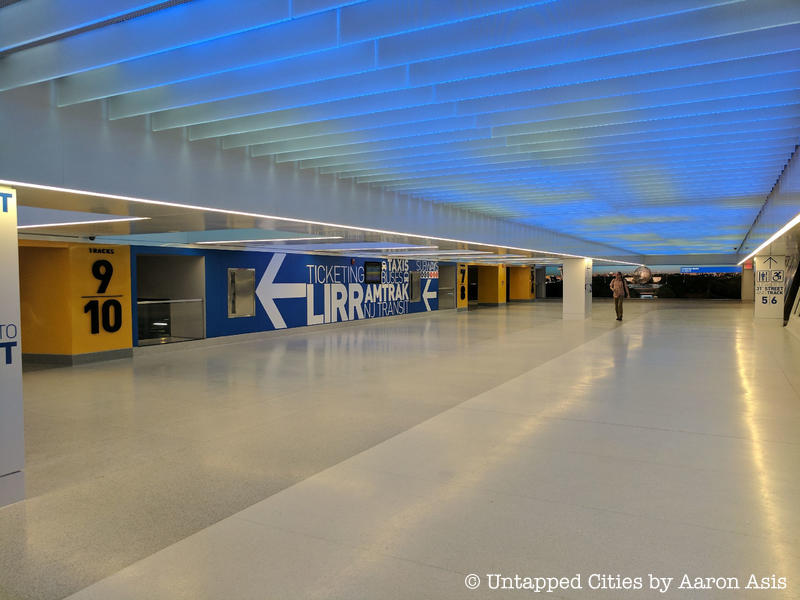
In June, the new West End Concourse opened at Penn Station, connecting the much-hated station with the James A. Farley Post Office (the future Moynihan Station). Any update to Penn Station is a welcome change (unless they start removing our beloved remnants of the original Penn Station!) and it is hoped that this new entrance and passageway will ease congestion in the station in general and will become an essential link when the Moynihan Station transformation if fully completed in 2020, where Amtrak trains will also run out of. The new track entrances are technically under Moynihan Station itself, not within Penn Station proper.
The new concourse is modern and colorful colorful, though a bit impersonal in the airport-style way, and comes with a lighted, cloud pattern ceiling, wide corridors and staircases, charging stations, bold signage, directional signage, and advertising for bTjhe oth local landmarks and New York State destinations. It’s clear this concourse is being thought of as a gateway, much like an airport. There’s also a new entrance on the northern end of Moynihan Station, with its Neoclassical architecture that once in correspondence to the style of the original Penn Station.
We’ll be visiting the new Moynihan Train Hall on our popular tour of the Remnants of Penn Station, where we track down relics from the original station. Join us for our next tours:
BOOK NOW
Also see more photos of the concourse here.
Next, check out our previous coverage of the James A. Farley Post Office and discover the Top 10 Secrets of the Original Pennslyvania Station.






